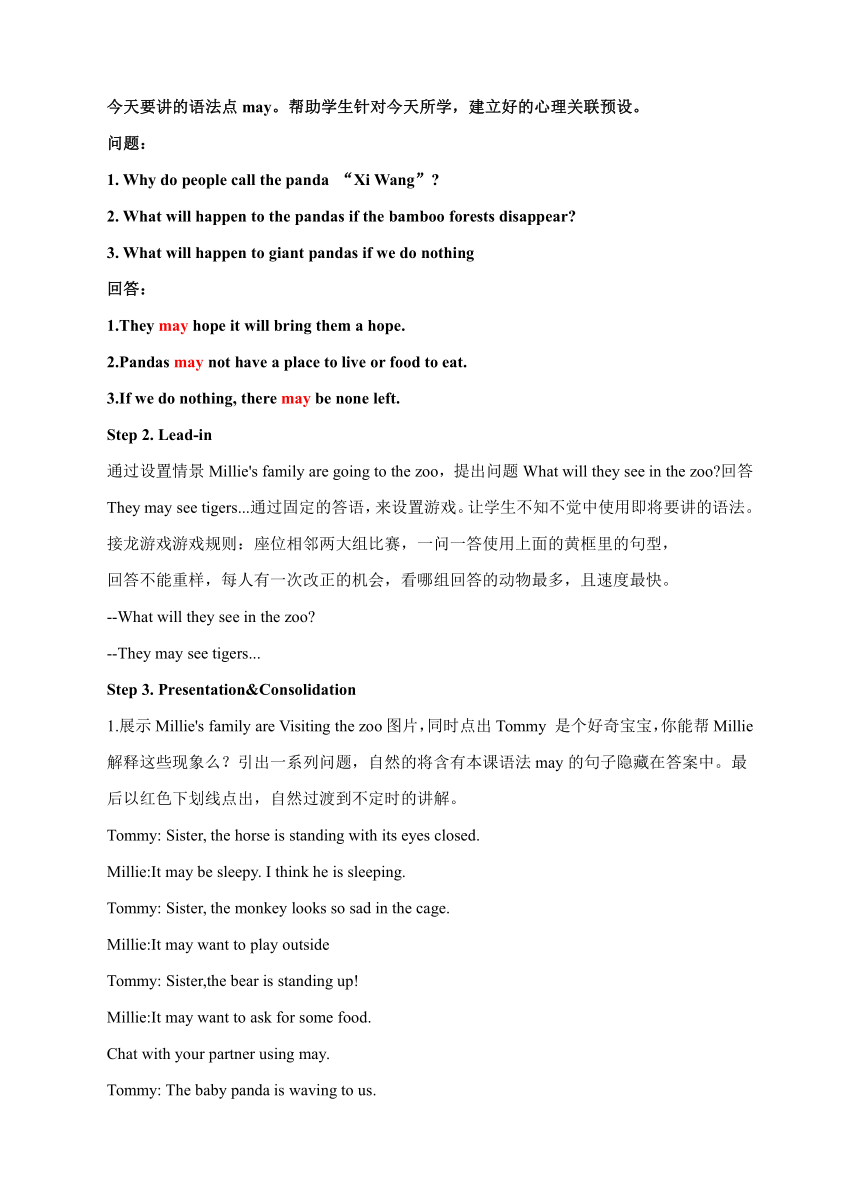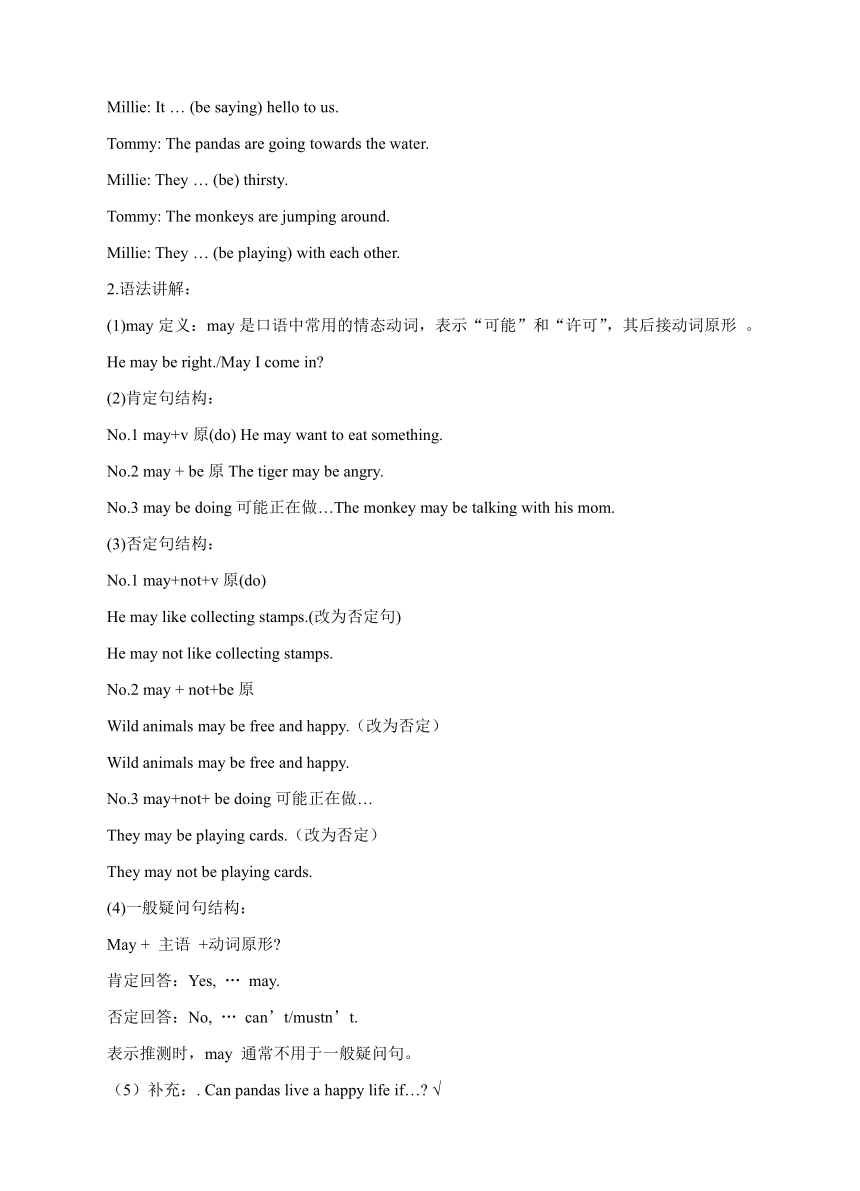牛津译林版八年级英语上册Module 2 Unit 5 Wild Animals Grammar 教案
文档属性
| 名称 | 牛津译林版八年级英语上册Module 2 Unit 5 Wild Animals Grammar 教案 |  | |
| 格式 | docx | ||
| 文件大小 | 23.9KB | ||
| 资源类型 | 教案 | ||
| 版本资源 | 牛津译林版 | ||
| 科目 | 英语 | ||
| 更新时间 | 2023-09-25 15:48:13 | ||
图片预览



文档简介
牛津译林版 八上 Unit 5 wild animals教案
Grammar
教学目标
学习目标:
学习使用may来表示可能性
学习使用动词不定式
能力目标:
掌握并能正确使用may来表示可能性
掌握并正确使用动词不定式
情感目标:
了解更多有关野生动物的信息,提升学生对于保护野生动物的意识。
教学重点
Using may for possibility, Using verbs+to-infinitives
教学难点
Using may for possibility, Using verbs+to-infinitives
教学方法
采用presentation, match and pair work,whole class activities, Practicing和Group work的学习策略,采用Task based teaching method和Situational Teaching Method的教学策略,利用教学图片、幻灯片或制作多媒体课件来展开课堂。
课前准备
1.教师准备: 使用‘学乐师生’拍照\录像\录音,收集学生典型成果,在‘授课’系统中展示”。 制作能显示本课时重点内容的图片及多媒体课件。
2.学生准备:课前预习本课时所学词汇、句型及课文内容,并进行适当的总结、归类。
课时安排
本节课共一课时
教学过程
Step 1. Revision
教师通过展示熊猫图片,并提出下列问题,来回顾上节课所学知识。并通过回答重点标出今天要讲的语法点may。帮助学生针对今天所学,建立好的心理关联预设。
问题:
1. Why do people call the panda “Xi Wang”
2. What will happen to the pandas if the bamboo forests disappear ·com
3. What will happen to giant pandas if we do nothing
回答:
1.They may hope it will bring them a hope.
2.Pandas may not have a place to live or food to eat.
3.If we do nothing, there may be none left.
Step 2. Lead-in
通过设置情景Millie's family are going to the zoo,提出问题What will they see in the zoo 回答They may see tigers...通过固定的答语,来设置游戏。让学生不知不觉中使用即将要讲的语法。
接龙游戏游戏规则:座位相邻两大组比赛,一问一答使用上面的黄框里的句型,
回答不能重样,每人有一次改正的机会,看哪组回答的动物最多,且速度最快。
--What will they see in the zoo
--They may see tigers...
Step 3. Presentation&Consolidation
1.展示Millie's family are Visiting the zoo图片,同时点出Tommy 是个好奇宝宝,你能帮Millie解释这些现象么?引出一系列问题,自然的将含有本课语法may的句子隐藏在答案中。最后以红色下划线点出,自然过渡到不定时的讲解。
Tommy: Sister, the horse is standing with its eyes closed.
Millie:It may be sleepy. I think he is sleeping.
Tommy: Sister, the monkey looks so sad in the cage.*com
Millie:It may want to play outside
Tommy: Sister,the bear is standing up!
Millie:It may want to ask for some food.
Chat with your partner using may.
Tommy: The baby panda is waving to us.
Millie: It … (be saying) hello to us.
Tommy: The pandas are going towards the water.
Millie: They … (be) thirsty.
Tommy: The monkeys are jumping around.
Millie: They … (be playing) with each other.
语法讲解:
(1)may定义:may是口语中常用的情态动词,表示“可能”和“许可”,其后接动词原形 。
He may be right./May I come in
肯定句结构:
No.1 may+v原(do) He may want to eat something.
No.2 may + be原The tiger may be angry.
No.3 may be doing可能正在做…The monkey may be talking with his mom.
否定句结构:
No.1 may+not+v原(do)
He may like collecting stamps.(改为否定句)
He may not like collecting stamps.
No.2 may + not+be原
Wild animals may be free and happy.(改为否定)
Wild animals may be free and happy.
No.3 may+not+ be doing可能正在做…
They may be playing cards.(改为否定)
They may not be playing cards.
一般疑问句结构:
May + 主语 +动词原形
肯定回答:Yes, … may.
否定回答:No, … can’t/mustn’t.
表示推测时,may 通常不用于一般疑问句。
(5)补充:. Can pandas live a happy life if… √
May pandas live … ×
总结1:can常用于否定句、一般疑问句。
He can’t know the truth. 他不可能知道真相。
He may not know the truth. 他可能不知道照相。
总结2:都表否定,但是意思不同。
3.语法讲解完毕,给出简单的单项选择练习,学生一起回答。然后转到课本的练习,给学生3分钟时间自己完成,然后当堂核对答案,有不懂的当堂讲解。
先给学生使用may的机会,让学生在用中开始理解may的用法,最后再做总结讲解may的用法。而不是开始讲may的用法再给出用的场景,变被动学习语法为主动。最后给出练习巩固所学。当堂学,当堂消化。.com
4.教师通过展示熊猫图片,并提出下列问题,来回顾上节课所学知识。并通过回答重点标出今天要讲的第二个语法点不定式。帮助学生针对今天所学,建立好的心理关联预设。
(1).When did Xi Wang start to go outside for the first time
She started to go outside at four months old.
. When Xi Wang was six months old, what did she begin to eat
She began to ear bamboo.
(3). What did Xi Wang learn to do when she was 20 months old
She learnt to look after herself when she was 20 months old.
通过上述例句,自然引出不定时。给出一篇长文章,让学生从中找出不定式结构。看谁找的最快,最准确。准备开始不定式的讲解:
(1)什么是动词不定式(‘to-infinitives’)?
上面例子中主要行为动词后面的动词都采用了“to + 动词原形”的结构,我们把这种结构称为动词不定式(有时可以不带to)。动词不定式没有人称和数的变化,在句子中不能单独作谓语,其否定形式是“not to + 动词原形”。
不定式的肯定式和否定形式,列举后接不定式的常见动词及句型。
语法讲解完毕,给出简单练习,用框中所给动词的正确形式填空。学生一起回答。然后让学生回顾课本,完成课本练习。老师在教室走动,检查学生的答题情况,也让老师及时得到反馈,当堂核对答案,针对学生做错的较多的题,进行重点讲解。
补充说明:感官动词、使役动词后接不带to的不定式。口诀形式帮助记忆。
不定式有 to do 和 do,多数加 to do 少数加 do,
下列动词后省去 to ,“三看”“两听” “一感觉”,
外加三个“小使役”,保你永远不忘记!
小试牛刀。
1.They are preparing __________(have) a sports meeting.
2.Jim agreed __________(go) to the West Lake.
3.It’s easy ____________(play) softball.
4. What made you_______ (feel) sad
5.Mr White learned _________(ride) a horse last year.
6. We will try our best __________(read) more books.
7. Let’s ________(share) our joys together.
8. I don’t know where___________(visit ) next year
9.Max wondered how___________(start) a campfire.
10. Are you ready___________(drive) me home
11. Last week, we chose _______ (visit) Beijing.
Step 3 summary
总结部分,老师可以先让学生来总结本节课我们学习的内容,然后老师再带领学生一起做最后的梳理。
1. 当我们猜测某件事发生的可能性时,常用may来表示“也许”、“可能”。
2. 当句子中已经有谓语动词,而我们又要表达不止一个动作概念时,其余的动词可以使用非谓语形式表达。动词不定式就是动词的一种非谓语形式。其肯定形式是“to + 动词原形”,
其否定形式是“not to + 动词原形”。无人称、数和时态的变化。
Step 4 中考链接Exercise
I. 单项选择。
1. — Don’t forget ______ your homework, John.
— Ok, I’ll do it right now. [2011怀化]
A. doing B. do C. to do
2. — Have you decided which senior high school to choose
— Not yet. I ______ go to Moonlight School. [2012江苏南京]
A. must B. may
C. need D. Should
3. — Excuse me, when are we going to have a picnic
— I’m not sure, Ask our monitor, please. He ______ know. [2012江苏扬州]
A. need B. can C. may D. shall
4. — Do you have any plans for this weekend
— I'm not sure. I ______ go climbing Mount Yuntai. [2012河南]
A. must B. need C. may D. Can
5. — Is Jim coming by train
— I’m not sure. He ______ drive his car. [2012四川凉山]
A. must B. may C. Need
6. Drivers shouldn't be allowed ______ after drinking, or they will break the law. [2012湖北咸宁]
A. drive B. driving
C. to drive D. to be driven
II. 完成句子。
1. 他可能认识你。
He _________ you.
2. 他们可能下周去长城。
They _________ the Great Wall next week.
3. 我们同意马上离开。
We agreed ________ at once.
4. Laura计划到中国一些名胜之地旅游。
Laura ____________ some places of interest in China. *com
5. 你愿意和他一起工作吗?
Would you _____________ with him
Step 5 Homework
1. Review Grammar and make some sentences with may and verbs + to-infinitives.
2. Preview Integrated skills on Pages 63 and 64
3.Finish the Exercises in the Ss’ workbooks.
Grammar
教学目标
学习目标:
学习使用may来表示可能性
学习使用动词不定式
能力目标:
掌握并能正确使用may来表示可能性
掌握并正确使用动词不定式
情感目标:
了解更多有关野生动物的信息,提升学生对于保护野生动物的意识。
教学重点
Using may for possibility, Using verbs+to-infinitives
教学难点
Using may for possibility, Using verbs+to-infinitives
教学方法
采用presentation, match and pair work,whole class activities, Practicing和Group work的学习策略,采用Task based teaching method和Situational Teaching Method的教学策略,利用教学图片、幻灯片或制作多媒体课件来展开课堂。
课前准备
1.教师准备: 使用‘学乐师生’拍照\录像\录音,收集学生典型成果,在‘授课’系统中展示”。 制作能显示本课时重点内容的图片及多媒体课件。
2.学生准备:课前预习本课时所学词汇、句型及课文内容,并进行适当的总结、归类。
课时安排
本节课共一课时
教学过程
Step 1. Revision
教师通过展示熊猫图片,并提出下列问题,来回顾上节课所学知识。并通过回答重点标出今天要讲的语法点may。帮助学生针对今天所学,建立好的心理关联预设。
问题:
1. Why do people call the panda “Xi Wang”
2. What will happen to the pandas if the bamboo forests disappear ·com
3. What will happen to giant pandas if we do nothing
回答:
1.They may hope it will bring them a hope.
2.Pandas may not have a place to live or food to eat.
3.If we do nothing, there may be none left.
Step 2. Lead-in
通过设置情景Millie's family are going to the zoo,提出问题What will they see in the zoo 回答They may see tigers...通过固定的答语,来设置游戏。让学生不知不觉中使用即将要讲的语法。
接龙游戏游戏规则:座位相邻两大组比赛,一问一答使用上面的黄框里的句型,
回答不能重样,每人有一次改正的机会,看哪组回答的动物最多,且速度最快。
--What will they see in the zoo
--They may see tigers...
Step 3. Presentation&Consolidation
1.展示Millie's family are Visiting the zoo图片,同时点出Tommy 是个好奇宝宝,你能帮Millie解释这些现象么?引出一系列问题,自然的将含有本课语法may的句子隐藏在答案中。最后以红色下划线点出,自然过渡到不定时的讲解。
Tommy: Sister, the horse is standing with its eyes closed.
Millie:It may be sleepy. I think he is sleeping.
Tommy: Sister, the monkey looks so sad in the cage.*com
Millie:It may want to play outside
Tommy: Sister,the bear is standing up!
Millie:It may want to ask for some food.
Chat with your partner using may.
Tommy: The baby panda is waving to us.
Millie: It … (be saying) hello to us.
Tommy: The pandas are going towards the water.
Millie: They … (be) thirsty.
Tommy: The monkeys are jumping around.
Millie: They … (be playing) with each other.
语法讲解:
(1)may定义:may是口语中常用的情态动词,表示“可能”和“许可”,其后接动词原形 。
He may be right./May I come in
肯定句结构:
No.1 may+v原(do) He may want to eat something.
No.2 may + be原The tiger may be angry.
No.3 may be doing可能正在做…The monkey may be talking with his mom.
否定句结构:
No.1 may+not+v原(do)
He may like collecting stamps.(改为否定句)
He may not like collecting stamps.
No.2 may + not+be原
Wild animals may be free and happy.(改为否定)
Wild animals may be free and happy.
No.3 may+not+ be doing可能正在做…
They may be playing cards.(改为否定)
They may not be playing cards.
一般疑问句结构:
May + 主语 +动词原形
肯定回答:Yes, … may.
否定回答:No, … can’t/mustn’t.
表示推测时,may 通常不用于一般疑问句。
(5)补充:. Can pandas live a happy life if… √
May pandas live … ×
总结1:can常用于否定句、一般疑问句。
He can’t know the truth. 他不可能知道真相。
He may not know the truth. 他可能不知道照相。
总结2:都表否定,但是意思不同。
3.语法讲解完毕,给出简单的单项选择练习,学生一起回答。然后转到课本的练习,给学生3分钟时间自己完成,然后当堂核对答案,有不懂的当堂讲解。
先给学生使用may的机会,让学生在用中开始理解may的用法,最后再做总结讲解may的用法。而不是开始讲may的用法再给出用的场景,变被动学习语法为主动。最后给出练习巩固所学。当堂学,当堂消化。.com
4.教师通过展示熊猫图片,并提出下列问题,来回顾上节课所学知识。并通过回答重点标出今天要讲的第二个语法点不定式。帮助学生针对今天所学,建立好的心理关联预设。
(1).When did Xi Wang start to go outside for the first time
She started to go outside at four months old.
. When Xi Wang was six months old, what did she begin to eat
She began to ear bamboo.
(3). What did Xi Wang learn to do when she was 20 months old
She learnt to look after herself when she was 20 months old.
通过上述例句,自然引出不定时。给出一篇长文章,让学生从中找出不定式结构。看谁找的最快,最准确。准备开始不定式的讲解:
(1)什么是动词不定式(‘to-infinitives’)?
上面例子中主要行为动词后面的动词都采用了“to + 动词原形”的结构,我们把这种结构称为动词不定式(有时可以不带to)。动词不定式没有人称和数的变化,在句子中不能单独作谓语,其否定形式是“not to + 动词原形”。
不定式的肯定式和否定形式,列举后接不定式的常见动词及句型。
语法讲解完毕,给出简单练习,用框中所给动词的正确形式填空。学生一起回答。然后让学生回顾课本,完成课本练习。老师在教室走动,检查学生的答题情况,也让老师及时得到反馈,当堂核对答案,针对学生做错的较多的题,进行重点讲解。
补充说明:感官动词、使役动词后接不带to的不定式。口诀形式帮助记忆。
不定式有 to do 和 do,多数加 to do 少数加 do,
下列动词后省去 to ,“三看”“两听” “一感觉”,
外加三个“小使役”,保你永远不忘记!
小试牛刀。
1.They are preparing __________(have) a sports meeting.
2.Jim agreed __________(go) to the West Lake.
3.It’s easy ____________(play) softball.
4. What made you_______ (feel) sad
5.Mr White learned _________(ride) a horse last year.
6. We will try our best __________(read) more books.
7. Let’s ________(share) our joys together.
8. I don’t know where___________(visit ) next year
9.Max wondered how___________(start) a campfire.
10. Are you ready___________(drive) me home
11. Last week, we chose _______ (visit) Beijing.
Step 3 summary
总结部分,老师可以先让学生来总结本节课我们学习的内容,然后老师再带领学生一起做最后的梳理。
1. 当我们猜测某件事发生的可能性时,常用may来表示“也许”、“可能”。
2. 当句子中已经有谓语动词,而我们又要表达不止一个动作概念时,其余的动词可以使用非谓语形式表达。动词不定式就是动词的一种非谓语形式。其肯定形式是“to + 动词原形”,
其否定形式是“not to + 动词原形”。无人称、数和时态的变化。
Step 4 中考链接Exercise
I. 单项选择。
1. — Don’t forget ______ your homework, John.
— Ok, I’ll do it right now. [2011怀化]
A. doing B. do C. to do
2. — Have you decided which senior high school to choose
— Not yet. I ______ go to Moonlight School. [2012江苏南京]
A. must B. may
C. need D. Should
3. — Excuse me, when are we going to have a picnic
— I’m not sure, Ask our monitor, please. He ______ know. [2012江苏扬州]
A. need B. can C. may D. shall
4. — Do you have any plans for this weekend
— I'm not sure. I ______ go climbing Mount Yuntai. [2012河南]
A. must B. need C. may D. Can
5. — Is Jim coming by train
— I’m not sure. He ______ drive his car. [2012四川凉山]
A. must B. may C. Need
6. Drivers shouldn't be allowed ______ after drinking, or they will break the law. [2012湖北咸宁]
A. drive B. driving
C. to drive D. to be driven
II. 完成句子。
1. 他可能认识你。
He _________ you.
2. 他们可能下周去长城。
They _________ the Great Wall next week.
3. 我们同意马上离开。
We agreed ________ at once.
4. Laura计划到中国一些名胜之地旅游。
Laura ____________ some places of interest in China. *com
5. 你愿意和他一起工作吗?
Would you _____________ with him
Step 5 Homework
1. Review Grammar and make some sentences with may and verbs + to-infinitives.
2. Preview Integrated skills on Pages 63 and 64
3.Finish the Exercises in the Ss’ workbooks.
